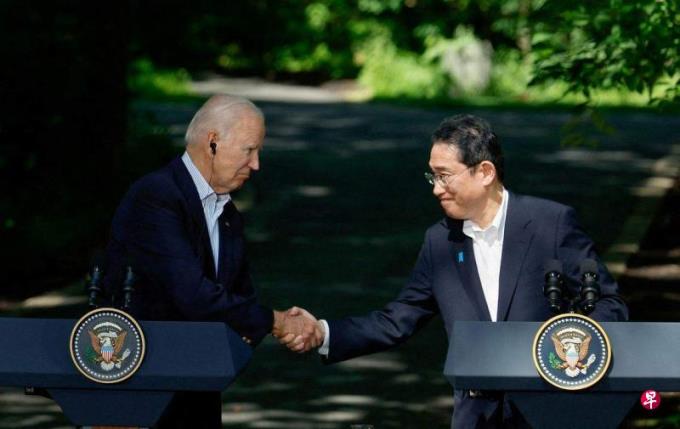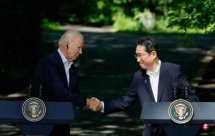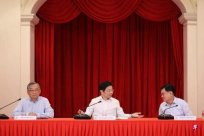
On the first day of the birth of AUKUS AUKUS (AUKUS), whether Japan will join will become the focus.The nature of the problem is that Australia and the United States come directly to China.The Australian and American attributes come to China are in line with Japan's policy orientation of China.The Australian -British and American three -sided security agreement reached in September 2021 appears to provide nuclear submarines for Australia. It is essentially a response to Australia's major transformation of Chinese foreign policy, and it is also a measure for the United States to curb China's influence in the Asia -Pacific region.
The Australian government wants to obtain US nuclear submarine promotion technology, which is a dream for 40 years.Every time the Australian side made relevant requirements, it was rejected by the United States.In fact, the Australian side's previous requests did not even reach the US President's desk.The US Navy excludes the possibility of Australia's nuclear power promotion technology.After 2021, the Asia -Pacific situation faced by Australia and the United States changed.The Australian side was sanctioned by China's trade due to the request to trace the crown disease. China ’s influence in the South Pacific has increased its concerns about the safety of surrounding surroundings.
At this moment, the Australian side begging the US nuclear submarine to promote technology, which has aroused full attention from US President Biden.Biden is implementing the alliance strategy to curb China, and providing Australian nuclear submarine technology to help check China.The US Australia's reaching nuclear -powered submarine agreement is equivalent to binding Australia more closely in a camp in the United States, eliminating the worries of the United States that Australia has fallen to China.Prior to the brewing of nuclear submarines in the United States and Australia, Australia signed a submarine trading contract with France to help Australia build conventional power submarines.However, the Australian side has turned interests to nuclear submarines and concluded that only with the help of the United States, Britain or the two, can nuclear submarines be obtained.In the end, a cooperation agreement was produced under the operation of Australia and the United States.
There are two pillars of the Australian -British and American agreements. First, Australia and the United States sharing nuclear submarine technology. The Royal Australian Navy will purchase at least eight nuclear -powered submarines equipped with conventional weapons.On March 13, 2023, Australia and the United States announced that it will build a new type of nuclear-powered submarine in the UK and Australia, called SSN-AUKUS, also known as SSN-A.In November 2023, Lincoln Reifsteck, the U.S. Navy Australia and Britain Integration and Entangering Project Manager, said the United States would sell Australian Block IV Virginia -class submarines in Australia in 2032 and 2035.
Second, technical cooperation.The technology here involves computers and network technology (focusing on network capabilities, artificial intelligence, quantum technology and other underwater capabilities), hypersonic and anti -hypersonic missiles, radar capabilities (deep space advanced radar capacity).Obviously, Australian and American technological cooperation is military cooperation.
Australia, Britain and the United States do not include Japan, but whether Japan will join has always attracted much attention.The reason is that Australia's motivation to seek three -sided cooperation is consistent with Japan's targets in response to China. Perhaps Japan can eagerly feel the impact of China than Australia.The controversy of the territorial sea on the issue of China and Japan on the Diaoyu Islands (Japanese island) has been on the sea for many years, and China's posture on the situation in the Taiwan Strait has led to the judgment of "there is something in Taiwan in Japan."After the Russian and Ukraine War, Japan also came to the judgment of "today's Ukraine is the tomorrow of East Asia".In April of this year, Japanese Prime Minister Kishita Kishita said in the United States that China may constitute a "unprecedented biggest strategic challenge" to Japan and the world, and the United States does not have to deal with global challenges alone.
Consistent motivation to China
The position of Kishida Wenxiong clearly shows that Japan will co -use the United States to curb China's influence with the United States.The purpose of Japan's participation in the US -Japan -India -Australian Sifang Security Dialogue (QUAD) is consistent with the influence of the four countries to curb China's influence.The Quartet's security dialogue mechanism was established in 2007. In the following eight years, the Quartet dialogue mechanism was basically paused.During the 2017 Manila participating in the Asia Gyeenity Summit, the leaders of the four countries decided to restore the Sifang security dialogue mechanism.The outside world generally refers to the four -party dialogue mechanism as "Asian NATO".In fact, Australia, Britain, and the United States are more like the "Asian NATO". Although Japan does not participate in the construction of nuclear submarines, the United States and Japan have developed a new type of interception missile and supersonic missiles, which is completely in line with the second pillar of Australia and the United States.
Japan's joining Australia, Britain, and the United States is logical, which is not only in line with the United States' Indo -Pacific Strategy, but also in the need for Japan to deal with China.Although Britain occasionally appeared in the Asia -Pacific region, Japan -Yingguang Island Agreement provided a legal basis for Britain and Japan's defense cooperation.Joining Australia and the United States in Japan can be regarded as the natural extension of the Japanese and American Military Alliance.Japan and Australia have signed a joint declaration of security cooperation to reiterate their support for international order based on rules.Therefore, there is no legal obstacle to joining Australia and the United States in Japan.
Although the Japanese Maritime Self -Defense Force does not have nuclear -powered submarines at present, the conventional submarine fleet is the best in the world. It can contribute to the Australian submarine's leading non -nuclear technology and gradually pave the way for Japan's nuclear submarine.Japan's high -tech capabilities can complement the United States.Australia, Britain, and the United States plans to provide nuclear submarines to Australia, which will make the Australian Navy and the United States and British Navy more closely linked, and combine with Japan's capabilities in the East China Sea and the West Pacific region.The prototype of "Asian Little NATO" is obvious.
Australia, Britain, and the United States said in a joint statement on April 8 this year that the three countries are considering carrying out advanced capabilities projects through Australia and Britain and Japan.The statement issued by the British government said: "Awareness of Japan's advantages and close bilateral defense partnerships with these three countries, we are considering cooperation with the advanced capabilities of the second pillar of the three -sided security partner agreement with Japan." In April,On the 9th, Australian Prime Minister Albanis said: "There is no plan to increase Australian British and American members." Australian Defense Minister Marce reiterated that Australia and the United States may cooperate with Japan in specific technical projects, but Japan will not become new members.This is due to Australia's crimes in order to improve China -Australia's economic and trade relations, and Japan is afraid of joining Australia and the United States.
Japan is unlikely to be invited to participate in the cooperation of the first pillar of Australia and the United States in the short term, but Japan's joining the second pillar has been written in the Japan -US joint statement in April this year.The statement pointed out: "Recognize Japan's advantages and bilateral defense partnerships close to Australia and Britain, Australian, British and American partners, Australia, Britain, and the United States, they are considering cooperation with Japan on the second pillar advanced capabilities of Australia and the United States."
Japan and the United States will take into account China's feelings, so even if Japan has actually participated in the second pillar cooperation, it may also be low -key, so there is no need to sound.The "potential" in the Asia -Pacific region determines that Japan has joined Australia and the United States.This "potential" also caused South Korea and Canada to express their willingness to join the second pillar of Australia and the United States.This "potential" should be part of the unscrupulous change in a century.
The author is Shanghai current affairs commentator




